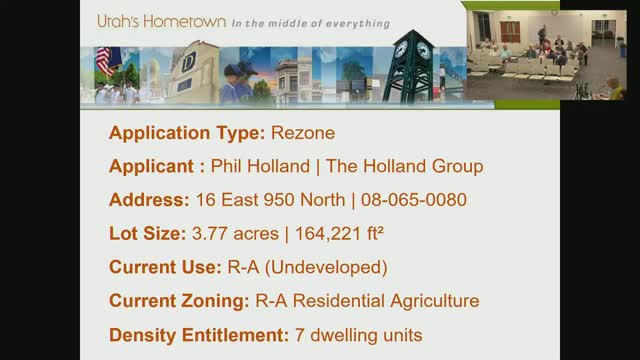Farmington City considers rezone for mixed-use development amid housing demands
April 25, 2025 | Kaysville, Davis County, Utah
Thanks to Excel Chiropractic and Scribe from Workplace AI , all articles about Utah are free for you to enjoy throughout 2025!

This article was created by AI using a video recording of the meeting. It summarizes the key points discussed, but for full details and context, please refer to the video of the full meeting. Link to Full Meeting
The primary discussion centered on a rezone request for a property located east of a previously discussed parcel. The applicant sought to change the zoning from Residential Agricultural (RA) to Residential Medium Density (RM). The area in question is situated on the south side of 950 North, adjacent to the West Davis Corridor. The zoning map indicated that the surrounding areas include various residential and agricultural zones, with the southern boundary being primarily Agricultural Estates (AE) in Farmington City.
The staff report referenced the 2022 General Plan, which designates the area for general commercial use. The commission explored the possibility of a mixed-use project that would incorporate medium-density housing, but ultimately decided to separate the applications for commercial and residential developments due to uncertainties regarding commercial users.
The General Plan outlines five guiding principles, one of which emphasizes the need for diverse housing options to meet the community's economic and lifestyle needs. Currently, 92% of Kaysville's residential properties are zoned for single-family homes, which limits housing diversity. The commission noted a public comment from a local family struggling to find affordable housing options, underscoring the need for varied housing types.
The meeting also addressed state legislative requirements for moderate-income housing. The commission is obligated to report annually on the status of housing applications and compliance with state goals. The discussion highlighted the importance of rezoning to facilitate the development of moderate-income housing, aligning with the state’s objectives.
In conclusion, the commission decided to move forward with a development agreement and site plan for the proposed rezone, reflecting a proactive approach to addressing community housing needs while navigating the complexities of local zoning regulations. The next steps will involve further discussions and evaluations as the project progresses.
Converted from Planning Commission Meeting 04-24-2025 meeting on April 25, 2025
Link to Full Meeting
Comments
View full meeting
This article is based on a recent meeting—watch the full video and explore the complete transcript for deeper insights into the discussion.
View full meeting
